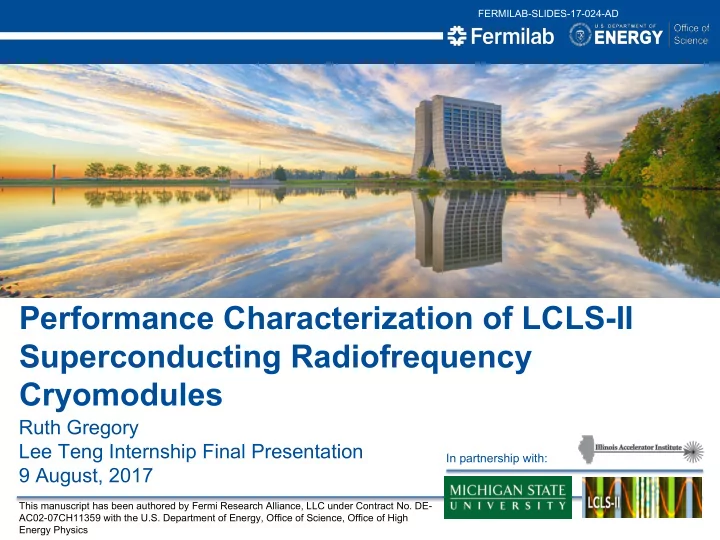

FERMILAB-SLIDES-17-024-AD Performance Characterization of LCLS-II Superconducting Radiofrequency Cryomodules Ruth Gregory Lee Teng Internship Final Presentation In partnership with: 9 August, 2017 This manuscript has been authored by Fermi Research Alliance, LLC under Contract No. DE- AC02-07CH11359 with the U.S. Department of Energy, Office of Science, Office of High Energy Physics
Outline ● Introduction ○ LCLS-II and Fermilab’s Contributions ● Motivation for Cryomodule Testing ● Analysis Methods ● Results ● Conclusion/Outlook Ruth Gregory | Performance Characterization of LCLS-II Superconducting 2 8/9/17 Radiofrequency Cryomodules
Linear Coherent Light Source (LCLS-II) and Fermilab’s Contributions ● LCLS II is a 2 nd generation x-ray free electron laser being constructed at SLAC National Accelerator Laboratory. ● Fermilab’s contributions to LCLS-II include designing, assembling, and testing seventeen 1.3 GHz and two 3.9 GHz cryomodules ● These cryomodules consist of eight nine-cell superconducting cavities. SRF cavity at Fermilab’s cryomodule test stand 1.3 GHz Superconducting Radio Frequency (SRF) cavity Ruth Gregory | Performance Characterization of LCLS-II Superconducting 3 8/9/17 Radiofrequency Cryomodules
Motivation for Cryomodule Testing ● Performance criteria are set for the level of field emission (radiation) and dark current produced by these cryomodules ● Assess which of the eight cavities produce the most (or any) radiation or dark current. ● Map out the radiation and dark current as a function of accelerating voltage. ● For each cavity determine: ○ Peak radiation ○ Cavity gradient (MV/m) where detectable radiation starts to appear ● This information will be included in the data travelers that will be sent to SLAC along with the cryomodules. Ruth Gregory | Performance Characterization of LCLS-II Superconducting 4 8/9/17 Radiofrequency Cryomodules
Analysis Methods ● Cryomodule data including gradient and radiation levels is collected through Fermilab’s Accelerator Control System (ACNET) archiving routines. ● A C++/ROOT program was developed to view and analyze the cryomodule data. ● This program generates: ○ Plots of the data from each cryomodule device over time ○ Plots of cavity voltage vs radiation ○ Plots of dark current vs cavity voltage ○ Data tables containing: ■ Maximum values for each cryomodule device ■ Peak radiation within any gradient range Ruth Gregory | Performance Characterization of LCLS-II Superconducting 5 8/9/17 Radiofrequency Cryomodules
8/9/17
Results This plot shows the data from each cryomodule device plotted over time. The voltage cavity data has y-axis units of MV/m, and is plotted with dotted lines. The radiation detector data has y-axis units of mrem, and is plotted with solid lines. Ruth Gregory | Performance Characterization of LCLS-II Superconducting 7 8/9/17 Radiofrequency Cryomodules
Results (cont.) ● These plots show the radiation levels for various radiation detectors plotted over the gradient for voltage cavities 5 (left) and 2 (right). ● The lines are linear fits of the data points in the range of 12 MV/m to the cavity voltage corresponding to the maximum radiation level for the given radiation detector. ● The data points included in the fit function are star-shaped. Ruth Gregory | Performance Characterization of LCLS-II Superconducting 8 8/9/17 Radiofrequency Cryomodules
Results (cont.) ● These are the plots from the previous slide zoomed-in on the point at which (most of) the fit lines intersect. ● This intersection point is approximated as the gradient at which field emission starts to appear. ● From these plots one can conclude that the onset of field emission for cavity 5 is just below 14 MV/m, and that cavity 2 has very little (if any) field emission. Ruth Gregory | Performance Characterization of LCLS-II Superconducting 9 8/9/17 Radiofrequency Cryomodules
Results (cont.) ● These are screenshots of the data tables produced by the ROOT/C++ program. ● The table on the left shows the maximum values recorded by each cryomodule device. ● The right table on the right shows the peak radiation values for each voltage cavity and for each radiation detector in the range of 15.5 and 16.6 MV/m. Ruth Gregory | Performance Characterization of LCLS-II Superconducting 10 8/9/17 Radiofrequency Cryomodules
Conclusion and Outlook ● Cryomodule field emission and dark current Data can now be obtained mostly automatically using an ACL script and the Root/C++ program. ● The Root/C++ program can be used to analyze data from any cryomodule. ● Next steps: ○ Find a more precise and objective way of finding the cavity gradient where detectable radiation starts to appear. ○ Perform a more complete analysis of dark current production. ○ Make a short tutorial for future users on how to use the ACL script and ROOT/C++ program. Ruth Gregory | Performance Characterization of LCLS-II Superconducting 11 8/9/17 Radiofrequency Cryomodules
Acknowledgements Thank you to: ● Elvin Harms, my mentor ● Brian Hendricks, for creating the ACL scripting language ● Eric Prebys and Rosa Foote for coordinating the Lee Teng Internship Ruth Gregory | Performance Characterization of LCLS-II Superconducting 12 8/9/17 Radiofrequency Cryomodules
References [1] T. Arkan et al., “LCLS-II 1.3 GHz Design Integration for Assembly and Cryomodule Assembly Facility Readiness at Fermilab,” in Proc. 17th Int. Conf. on RF Superconductivity (SRF2015) , Whistler, BC, Canada, Sep. 2015. [2] E. Harms et al. , “ Fermilab Cryomodule Test Stand Design and Plans,” in Proc. 17th Int. Conf. on RF Superconductivity (SRF2015) , Whistler, BC, Canada, Sep. 2015. Ruth Gregory | Performance Characterization of LCLS-II Superconducting 13 8/9/17 Radiofrequency Cryomodules
Backup Slides Ruth Gregory | Performance Characterization of LCLS-II Superconducting 14 8/9/17 Radiofrequency Cryomodules
Results (cont.) Top Plots: Full graph of cavity voltage vs radiation for cavities 5 (left) and 6 (right). Bottom Plots: Close up of the regions where the fit lines on the plots intersect. Ruth Gregory | Performance Characterization of LCLS-II Superconducting 15 8/9/17 Radiofrequency Cryomodules
Recommend
More recommend